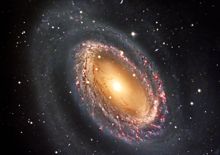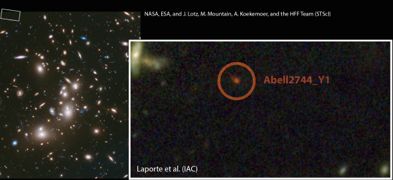
Formation and Evolution of Galaxies
Galaxies have progressively formed through a complex combination of gas accretion, star formation, and merging with other galactic units. The Formation and Evolution of Galaxies research line aims:
1) to survey the 3D structure of the Milky Way and resolve stellar populations in its Globular Cluster system (Marín-Franch et al. 2009), its satellite galaxies (Gallart, Zoccali & Aparicio 2005), and in other nearby Galaxies such as, particularly, M33 and the Magellanic Clouds, as a way to confirm models of galaxy formation in various cosmological scenarios;
2) disentangle among the different scenarios proposed to explain the star formation history of the Universe and decipher the role of merging, accretion and supermassive black holes in the centers of galaxies; IAC will collect an unprecedentedly large sample of superb-quality spectra of distant galaxies with GTC and VLT and obtain ultra high spatial resolution imaging and 3D spectra of the nearest galaxies with GTCAO+FRIDA to explore the supermassive black hole activity cycle and its influence on galaxy evolution;
3) study the physics of star formation and the conditions of the interstellar medium in the first galaxies conducting follow-up studies with GTC and the Millimeter Interferometers ALMA, and IRAM of high-z galaxies discovered in the extragalactic surveys with the Herschel Submillimeter Space Observatory (co-Is are I. Pérez- Fournón and J. Cepa) and the Spitzer satellite; and narrow-band surveys and spectroscopic follow-up of Lyman alpha emitters with the unique capabilities of the OSIRIS (P.I. J. Cepa) and EMIR (P.I. F. Garzón) optical and infrared spectrographs on GTC. Use the nearby galaxies, particularly those at low Z, as probes for the early Universe.
4) The IAC leads a collaboration to obtain spectroscopy of all the known gravitational lenses using the VLT, Magellan, MMT, GTC and in the future HARMONI (the first light instrument of the E-ELT, co-I E. Mediavilla) and detect the presence of dark matter in the halos of galaxies (MACHOS and subhalos) by measuring the difference in magnification of the continuum and the emission lines.

5) The recently created theoretical group led by the advanced Severo Ochoa fellow Claudio Dalla Vecchia aims at linking observations and theory; the group, together with the international collaborations of its members, will be performing simulations of galaxy formation and evolution in order to strengthen the interpretation of observational data and provide predictions for future observations.
Goals:
- Measure the 3D structure of the Milky Way and resolve stellar populations in its Globular Cluster system, its satellite galaxies and in nearby galaxies to constrain models of galaxy formation in cosmological scenarios;
- Study the physics of star formation and the conditions of the interstellar medium over the history of the Universe and decipher the role of merging, accretion and supermassive black holes in the centers of galaxies.
Specific Scientific Outputs:
2012
- IAC participated in the ESO spectroscopic survey started at VLT 8m to complement the GAIA space mission in the 3D exploration of our Galaxy.
- Globular cluster systems were used as tracers of environmental effects on Virgo early-type dwarfs.
- The Anomalous Cepheids population of the Large Magellanic Cloud and of the dwarf galaxy Leo I provided constraints on the formation mechanism and the properties of the parent population.
- Completed the study on the relation between gas and star formation for the galaxies sampled by the Nearby Galaxies Legacy Survey.
- The GHaFaS Fabry Perot spectrometer provided new information about the effects of galaxy interaction on star formation and the feeding of Active Galactic Nuclei, AGNs.
- Extragalactic surveys: IAC has contributed the Herschel satellite Key Project (HerMES) and the largest one in Open Time (Herschel-ATLAS). It was published in Nature (Page et al.), the role of high X-ray luminosity AGNs in the suppression of star formation in their host galaxies. IAC participated in the SDSS III- ninth Data Release, a database of more than 2 million spectra of galaxies, stars and quasars, including for the first time spectra of a large number of objects of the BOSS project.
- The size of the Broad Line Region was derived from microlensing measurements of the broad emission lines in 16 lensed quasars.
2013

- At the end of 2013, the Hubble Space Telescope has started its last flagship program, the "Frontier Fields". Hubble, Spitzer and Chandra - will dedicate a large amount of their observing time to observe six galaxies clusters, who act as additional lenses and amplify the light from background sources. Laporte et al. A&A Letters (2014, 562, L8) have analyzed the first Frontier Fields observations of the cluster Abell 2744, and found a z=8 galaxy candidate. This is one of the brightest galaxies detected at such early cosmic epochs and shows the potential of the Frontier Fields project.
- An extension of the BaSTI stellar evolution database to extremely metal-poor (Z = 0.00001) and super-metal-rich (Z = 0.05) metallicities, with both scaled-solar and alpha-enhanced ([alpha/Fe]=0.4) heavy element distributions (Pietrinferni, Cassisi, Salaris & Hidalgo, 2013, A&A, 558, 46) has been presented. This work will help to study the most metal-poor populations found in Local Group faint dwarf galaxies and the metal-rich component of the Galactic bulge.
- In a study of the variable stars in the irregular galaxy Leo A, based on HST/ACS data, an unusually small number of RR Lyrae stars (10) has been found. This supports independent findings indicating that the amount of old population in this galaxy is very small, unlike in any other Local Group galaxy. This makes of Leo A an unique object to-date (Bernard, Monelli, Gallart et al. 2013, MNRAS, 432, 3047).
- The star formation history of three Large Magellanic Cloud (LMC) outer disk fields has revealed two main periods of star formation: one at old ages (> 10 Gyr), and another at intermediate and young ages (< 5 Gyr). Their relative importante changes with radius, such that the fraction of old population increases for increasing galactocentric radius. Moreover, the age of the youngest population gets younger toward smaller galactocentric radius. This gradient implies an outside-in quenching of the star formation resulting either from gas depletion, or from the compression of the gas disc as ram pressure from the Milky Way halo acted on the LMC interstellar medium (Meschin, Gallart et al. 2014, MNRAS, 438, 1067).
- A study of the dynamical status of the galaxy cluster Abell 1914 has suggested a new scenario to explain clusters with radio haloes through mergings. (Barrena, Girardi & Boschin 2013, MNRAS 430, 3453).
- Using the ultradeep near-infrared imaging obtained with the Hubble Space Telescope on the Hubble Ultra Deep Field, the properties of the stellar haloes of two Milky Way-like galaxies at z ˜ 1 were detected and explored for the first time. A pure passive evolutionary scenario, where the stellar populations of the high-z haloes simply fade to match the stellar halo properties found in the local universe, is consistent with the data (Trujillo & Bakos, ApJ 431, 1121).


